
Gladiolus is a genus of perennial cormous flowering plants in the iris family (Iridaceae).

Crocosmia (;), also known as montbretia, is a small genus of flowering plants in the iris family, Iridaceae. It is native to the grasslands of southern and eastern Africa, ranging from South Africa to Sudan. One species is endemic to Madagascar.
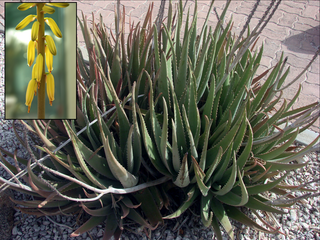
Aloe vera is a succulent plant species of the genus Aloe. It is widely distributed, and is considered an invasive species in many world regions.
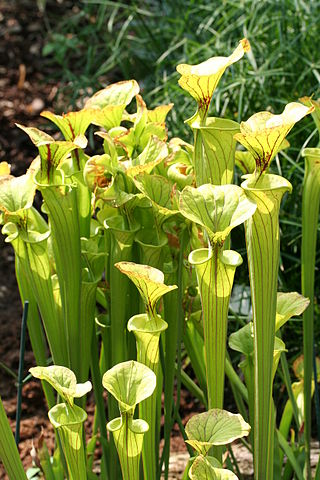
Sarracenia flava, the yellow pitcherplant, is a carnivorous plant in the family Sarraceniaceae. Like all the Sarraceniaceae, it is native to the New World. Its range extends from southern Alabama, through Florida and Georgia, to the coastal plains of southern Virginia, North Carolina and South Carolina. Populations also exist in the Piedmont, Mendocino County, California and mountains of North Carolina.

Ixia is a genus of cormous plants native to South Africa from the family Iridaceae. Some of them are known as the corn lily. Some distinctive traits include sword-like leaves and long wiry stems with star-shaped flowers. It usually prefers well-drained soil. The popular corn lily has specific, not very intense fragrance. It is often visited by many insects such as bees. The Ixia are also used sometimes as ornamental plants. The genus is endemic to the Cape Provinces of western South Africa.
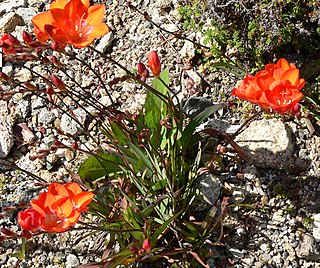
Tritonia is a genus of flowering plants in the iris family first described as a genus in 1802. They are naturally distributed across southern Africa, with a high concentration of species in Cape Province of western South Africa. The genus is closely related to the genus Ixia.

Romulea is a genus of flowering plants in the family Iridaceae, first described as a genus in 1772. It is found in Europe, the Mediterranean, the Arabian Peninsula, and Africa.

Gazania rigens, sometimes called treasure flower, is a species of flowering plant in the family Asteraceae, native to coastal areas of southern Africa. It is naturalised elsewhere and is widely cultivated as an ornamental plant.

Pimelea flava is a species of flowering plant in the family Thymelaeaceae and is endemic to south-eastern Australia. It is a shrub with narrowly elliptic to egg-shaped leaves arranged in opposite pairs, and compact clusters of 9 or more flowers with 2 or 4 elliptic to circular involucral bracts at the base. The flowers and bracts are white or yellow, depending on subspecies.
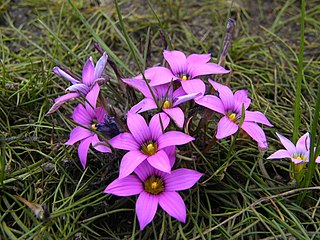
Romulea rosea is a herbaceous perennial plant in the family Iridaceae. It is a small plant, usually less than 20 cm high, with grass-like leaves. The flowers, which appear in spring, are pink with a yellow throat. Common names include Guildford grass, onion grass and rosy sandcrocus.

Miriam Phoebe de Vos was a leading South African botanist and academic. She was an expert on bulbous plants, especially Romulea. She also had a special interest in Moraea and Clivia.
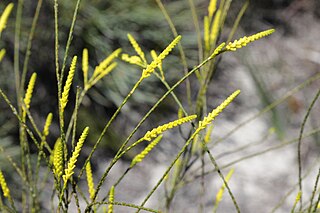
Micromyrtus flava is a species of flowering plant in the family Myrtaceae and is endemic to the south-west of Western Australia. It is a slender, erect shrub with spreading stems, narrowly-elliptic leaves and yellow flowers.

Romulea tortuosa is a herbaceous perennial geophyte in the family Iridaceae native to South Africa. It has a small corm in the soil, a few prostrate coiling leaves, and fragrant, trimerous yellow flowers, sometimes with six brown blotches on the inside near the bottom of the flower.

Romulea viridibracteata is a herbaceous perennial tuberous geophyte in the family Iridaceae. It is native to Pakhuis Pass in the Western Cape Province of South Africa.
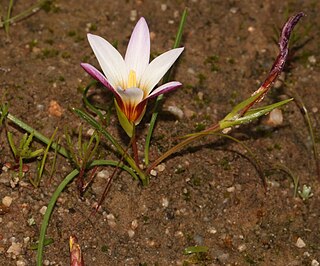
Romulea toximontana is low a herbaceous perennial geophyte in the family Iridaceae native to South Africa. It has a small corm in the soil, several linear leaves, white trimerous flowers, yolk-yellow near the centre and with a purple wash on the outside. The 1997 IUCN Red List of Threatened Plants lists this species as rare.

Romulea monadelpha is a herbaceous perennial geophyte in the family Iridaceae native to South Africa. It has a small corm in the soil, a few thread-like leaves, and trimerous dark red flowers with elaborate markings on the inside near the bottom of the flower. It is called karoo satynblom in Afrikaans.

Romulea columnae, the sand crocus, is a herbaceous perennial in the family Iridaceae. It is a small plant, with thin narrow leaves, and small scape which has small pink, pale purple or violet pointed flowers with darker veining and a gold or yellow throat. It is native to a wide area ranging from western Europe to the Mediterranean.
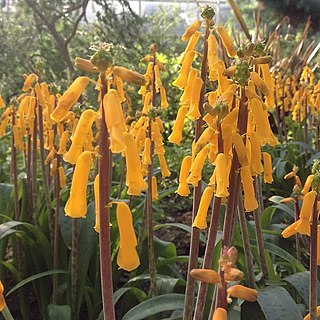
Lachenalia flava, the golden opal flower, is a species of flowering plant in the genus Lachenalia native to the southwest Cape Provinces of South Africa. It has gained the Royal Horticultural Society's Award of Garden Merit.
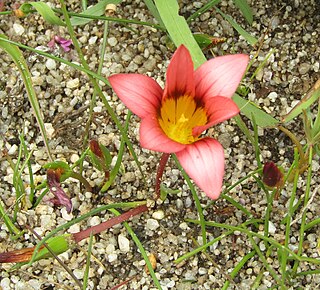
Romulea hirsuta is a geophyte from South Africa. It has pink flowers with dark marks at the edges of the yellow center.


















